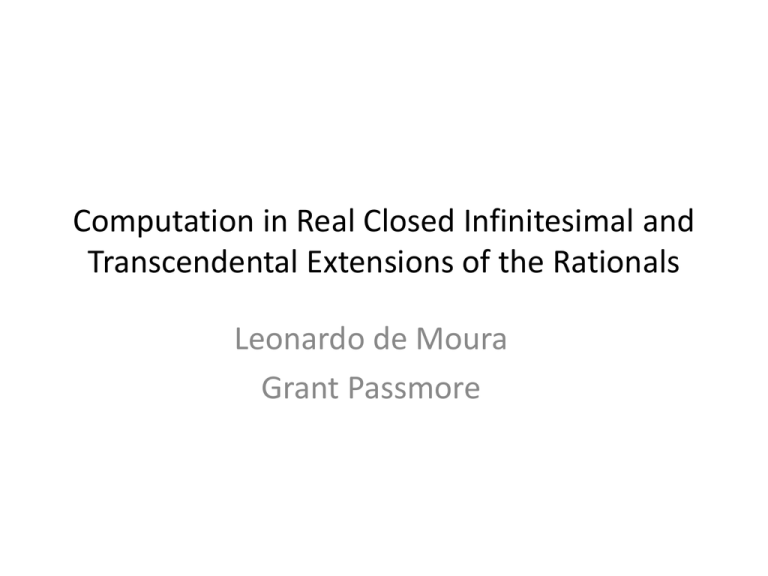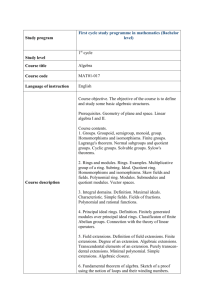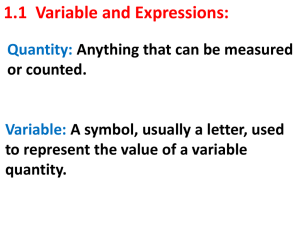Observation 2 - Leonardo de Moura
advertisement

Computation in Real Closed Infinitesimal and
Transcendental Extensions of the Rationals
Leonardo de Moura
Grant Passmore
What?
2+ 3
3
Infinitesimal
1 3 2 3 4
−
+
=
9
9
9
3 3
1+𝜖
100
>
10
𝜖2
2−1
Transcendental
𝜋+𝜖 <𝜋
FindRoots (1 − 2 𝑥 2 − 𝜖𝑥 3 + 𝜖 2 𝑥 5 )
Real Closed Fields
Ordered Field
Positive elements are squares ∀𝑥 𝑥 ≥ 0 ⇒ ∃𝑦 𝑥 = 𝑦 2
All polynomials of odd degree have roots
∀𝑎0 … 𝑎2𝑛 ∃𝑥 𝑥 2𝑛+1 + 𝑎2𝑛 𝑥 2𝑛 + … . +𝑎1 𝑥 + 𝑎0 = 0
⊆
ℝ
ℝ𝑎𝑙𝑔
Real Algebraic
Numbers
0, 1, 1 3 , 2, − 3,
𝑟𝑜𝑜𝑡 −1 − 𝑥 + 𝑥 5 , 1,2
5
,…
Real Closed Fields
⊆
ℝ
ℝ𝑎𝑙𝑔 = ℚ
Real Closure of the
Rational Numbers
Real Closed Fields
… , 2, 3 𝜋,
,…
⊆
ℝ
Field extension
𝐾, 𝐾 = ℚ(𝜋)
⊆
𝑟𝑜𝑜𝑡 − 𝜋 − 𝑥 + 𝑥 5 , 1,2
ℝ𝑎𝑙𝑔 = ℚ
1, 1 3 , 𝜋, 𝜋 + 1,
𝜋2 + 1
,…
2
Real Closed Fields
⊆
ℝ
⊆
𝐾1 , 𝐾1 = ℚ(𝜋)(𝑒)
⊆
𝐾, 𝐾 = ℚ(𝜋)
ℝ𝑎𝑙𝑔 = ℚ
1, 𝑒, 𝜋 + 𝑒,
𝑒2 + 𝜋
,…
2
Real Closed Fields
ℍ
ℝ
𝐾2 , 𝐾2 = ℚ(𝜋)(𝑒)(𝜖)
⊆
⊆
Hyperreals
⊆
𝐾1 , 𝐾1 = ℚ(𝜋)(𝑒)
⊆
𝐾, 𝐾 = ℚ(𝜋)
ℝ𝑎𝑙𝑔 = ℚ
Infinitesimal
Real Closed Fields
ℍ
ℝ
𝐾2 , 𝐾2 = ℚ(𝜋)(𝑒)(𝜖)
⊆
⊆
Hyperreals
⊆
𝐾1 , 𝐾1 = ℚ(𝜋)(𝑒)
⊆
𝐾, 𝐾 = ℚ(𝜋)
ℝ𝑎𝑙𝑔 = ℚ
Infinitesimal
Why?
NLSat: Nonlinear Arithmetic Solver (∃RCF) IJCAR 2012
(joint work with Dejan Jovanovic)
Also relevant for any CAD-based procedure, and
model generating solvers
NLSat bottlenecks:
• Real algebraic number computations
• Subresultant computations
NLSat
𝑥2 − 2 = 0
𝑦2 − 𝑥 + 1 < 0
Decide 𝑥 → − 2
NLSat
𝑥2 − 2 = 0
𝑦2 − 𝑥 + 1 < 0
Decide 𝑥 → − 2
There is no 𝑦 s.t. 𝑦 2 + 2 + 1 < 0
NLSat
𝑥2 − 2 = 0
𝑦2 − 𝑥 + 1 < 0
Decide 𝑥 → − 2
There is no 𝑦 s.t. 𝑦 2 + 2 + 1 < 0
Conflict resolution (and backtrack)
𝑦 2 − 𝑥 + 1 < 0 implies 𝑥 > 1
NLSat
𝑥2 − 2 = 0
𝑦2 − 𝑥 + 1 < 0
𝑥>1
Decide 𝑥 → 2
Decide 𝑦 → −1/2
NLSat
Example:
216 𝑥 15 + 4536 𝑥 14 + 31752 𝑥 13 − 520884 𝑥 12 −
42336 𝑥 11 − 259308 𝑥 10 + 3046158 𝑥 9 + 140742 𝑥 8 +
756756𝑥 7 − 5792221𝑥 6 − 193914𝑥 5 − 931392 𝑥 4 +
3266731𝑥 3 + 90972𝑥 2 + 402192 𝑥 + 592704
𝑦 5 − 𝑦 + (𝑥 3 +1)
Before: timeout (old package used Resultant theory)
After: 0.05 secs
NLSat + Transcendental constants
Nonlinear Arithmetic Solver
Transcendental Constants (e.g., MetiTarski)
𝑥2 − 𝜋 = 0
𝑦2 − 𝑥 + 1 < 0
Exact Nonlinear Optimization
(on demand)
Find smallest 𝑦 s.t. 𝐹 𝑦, 𝑥
Output:
unsat
unbounded
minimum(𝑎)
infimum(𝑎)
Exact Nonlinear Optimization
(on demand)
Find smallest 𝑦 s.t. 𝐹 𝑦, 𝑥
Observation 1:
Univariate 𝐹[𝑦] case is easy
Inefficient solution:
∃𝑥, 𝐹[𝑦, 𝑥]
Exact Nonlinear Optimization
(on demand)
Find smallest 𝑦 s.t. 𝐹 𝑦, 𝑥
Observation 2:
Adapt NLSat for solving the
satisfiability modulo assignment problem.
Satisfiability Modulo Assignment (SMA)
Given 𝐹 𝑦, 𝑥 and 𝑦 → 𝛼
Output:
sat
𝑦 → 𝛼, 𝑥 → 𝛽 satisfies 𝐹 𝑦, 𝑥
unsat(𝑆[𝑦]) 𝐹 𝑦, 𝑥 implies 𝑆[𝑦] and
𝑆[𝛼] is false
No-good sampling
𝐶ℎ𝑒𝑐𝑘 𝐹 𝑦, 𝑥 , 𝑦 → 𝛼1
= unsat 𝑆1 𝑦 , 𝐺1 = 𝑆1 [𝑦],
𝛼2 ∈ 𝐺1 , 𝐶ℎ𝑒𝑐𝑘 𝐹 𝑦, 𝑥 , 𝑦 → 𝛼2
= unsat 𝑆2 𝑦 , 𝐺2 = 𝐺1 ∧ 𝑆2 [𝑦],
𝛼3 ∈ 𝐺2 , 𝐶ℎ𝑒𝑐𝑘 𝐹 𝑦, 𝑥 , 𝑦 → 𝛼3
= unsat 𝑆3 𝑦 , 𝐺3 = 𝐺2 ∧ 𝑆3 [𝑦],
…
𝛼𝑛 ∈ 𝐺𝑛−1 , 𝐶ℎ𝑒𝑐𝑘 𝐹 𝑦, 𝑥 , 𝑦 → 𝛼𝑛
𝐺𝑛−1 ∧ 𝑆𝑛 [𝑦],
…
Finite decomposition property:
The sequence is finite
= unsat 𝑆𝑛 𝑦 , 𝐺𝑛 =
𝐺𝑖 approximates
∃𝑥, 𝐹[𝑦, 𝑥]
Exact Nonlinear Optimization
(on demand)
Univariate minimization
−∞
Related Work
Transcendental constants
MetiTarski
Interval Constraint Propagation (ICP)
RealPaver, Rsolver, iSat, dReal
Reasoning with Infinitesimals
ACL2, Isabelle/HOL
Nonstandard analysis
Real Closure of a Single Infinitesimal Extension [Rioboo]
Puiseux series
Coste-Roy: encoding algebraic elements using Thom’s
lemma
Our approach
Tower of extensions
Hybrid representation
Interval (arithmetic) + Thom’s lemma
Clean denominators
Non-minimal defining polynomials
Tower of extensions
ℚ ⊆
ℚ 𝜍1 ⊆
ℚ 𝜍1 𝜍2 ⊆
…
ℚ 𝜍1 𝜍2 … 𝜍𝑛 ⊆
…
Transcendental,
Infinitesimal, or
Algebraic extension
Tower of extensions
ℚ 𝑡1 … 𝑡𝑛 𝜖1 … 𝜖𝑚 𝛼1 … (𝛼𝑘 )
Transcendental
Extensions
Infinitesimal
Extensions
Algebraic
Extensions
Tower of extensions
Basic Idea:
Given (computable) ordered field 𝐾
Implement 𝐾(𝜍)
Tower of extensions
(Computable) ordered field 𝐾
Operations: +, −, ×, 𝑖𝑛𝑣, 𝑠𝑖𝑔𝑛
𝑎 < 𝑏 ⇔ 𝑠𝑖𝑔𝑛 𝑎 − 𝑏 = −1
Binary Rational
𝑎
2𝑘
Approximation: 𝑎𝑝𝑝𝑟𝑜𝑥 𝑎 ∈ 𝐵∞ -interval
𝐵∞ = 𝐵 ∪ −∞, ∞
𝑎 ≠ 0 ⇒ 0 ∉ 𝑎𝑝𝑝𝑟𝑜𝑥(𝑎)
Refine approximation
(Computable) Transcendental Extensions
𝑎𝑝𝑝𝑟𝑜𝑥(𝜋) 𝑘 ∈ 𝐵∞ -interval
∀𝑛 ∈
ℕ+ , ∃𝑘
1
∈ ℕ, 𝑤𝑖𝑑𝑡ℎ(𝑎𝑝𝑝𝑟𝑜𝑥(𝜋) 𝑘 ) <
𝑛
Elements of the extension are encoded as rational functions
𝜋2 + 𝜋 − 2
𝜋+1
(Computable) Transcendental Extensions
1 2 1
𝜋 + 𝜋+1
1
1
2
2
𝜋+
=
2
𝜋+1
𝜋+1
Standard normal form for rational functions
GCD(numerator, denominator) = 1
Denominator is a monic polynomial
(Computable) Transcendental Extensions
Refine interval
Interval arithmetic
Refine coefficients and extension
Zero iff numerator is the zero polynomial
If 𝑞 𝑥 is not the zero polynomial,
then 𝑞 𝜋 can’t be zero, since 𝜋 is transcendental.
Remark
𝜋 is transcendental with respect to ℚ
𝜋 is not transcendental with respect to ℚ(𝜋)
Infinitesimal Extensions
Every infinitesimal extension is transcendental
Rational functions
𝑠𝑖𝑔𝑛(𝑎0 + 𝑎1 𝜖 + … + 𝑎𝑛 𝜖 𝑛 )
sign of first non zero coefficient
1
𝑎𝑝𝑝𝑟𝑜𝑥 𝜖 = (0, 𝑘 )
2
Non-refinable intervals
1
𝑎𝑝𝑝𝑟𝑜𝑥
= (2𝑘 , ∞)
𝜖
Algebraic Extensions
𝐾 𝛼
𝛼 is a root of a polynomial with coefficients in 𝐾
Encoding 𝛼 as polynomial + interval does not work
𝐾 may not be Archimedian
Roots can be infinitely close to each other.
Roots can be greater than any Real.
Thom’s Lemma
We can always distinguish the roots of a polynomial in a
RCF using the signs of the derivatives
Algebraic Extensions
Roots: − 1/𝜖,
Three roots of
1/𝜖,
3
1/𝜖
Algebraic Extensions
The elements of 𝐾 𝛼 are polynomials 𝑞(𝛼).
Implement +, −, × using polynomial arithmetic.
Compute sign (when possible) using interval arithmetic.
Algebraic Extensions
𝛼 = (−2 + 𝑥 2 , 1,2 , {})
Let 𝑎 be 𝑞(𝛼) = 1 + 𝛼 3
We can normalize a by computing the polynomial remainder.
1 + x 3 = 𝑥 −2 + 𝑥 2 + (1 + 2𝑥)
1 + 𝛼 3 = 𝛼 −2 + 𝛼 2 + 1 + 2𝛼 = 1 + 2𝛼
𝑎 = 𝑟𝑒𝑚 1 + 𝑥 3 , −2 + 𝑥 2 (𝛼)
Polynomial
Remainder
Algebraic Extensions:
non-minimal Polynomials
Computing the inverse of 𝑞 𝛼 , where 𝛼 = 𝑝, 𝑎, 𝑏 , 𝑆
Find ℎ 𝛼 s.t. 𝑞 𝛼 ℎ 𝛼 = 1
Compute the extended GCD of 𝑝 and 𝑞.
𝑟 𝑥 𝑝 𝑥 +ℎ 𝑥 𝑞 𝑥 =1
𝑟 𝛼 𝑝 𝛼 +ℎ 𝛼 𝑞 𝛼 =1
0
Algebraic Extensions:
non-minimal Polynomials
We only use square-free polynomials 𝑝 in 𝛼 = 𝑝, 𝑎, 𝑏 , 𝑆
They are not necessarily minimal in our implementation.
𝑝(𝑥) = 𝑞(𝑥)𝑠(𝑥)
𝐾 𝑥 / 𝑝 ≅ 𝐾(𝛼)
Only is 𝑝 is minimal
Solution: Dynamically refine 𝑝, when computing inverses.
Algebraic Extensions
Given 𝐻 = ℎ1 , … , ℎ𝑛 , 𝑠𝑖𝑔𝑛𝑑𝑒𝑡 𝐻, 𝑝, 𝑎, 𝑏
Feasible sign assignments of 𝐻 at roots of 𝑝 in (𝑎, 𝑏)
Based on Sturm-Tarski Theorem
Ben-Or et al algorithm.
𝑠𝑖𝑔𝑛 𝑞 𝛼 where 𝛼 = (𝑝, 𝑎, 𝑏 , 𝑆)
𝑅 = 𝑠𝑖𝑔𝑛𝑑𝑒𝑡(𝑝𝑜𝑙𝑦 𝑆 , 𝑝, 𝑎, 𝑏 )
Algebraic Extensions: Clean Representation
Clean denominators of coefficients of 𝑝 in 𝛼 = 𝑝, 𝑎, 𝑏 , 𝑆
Use pseudo-remainder when computing Sturm-sequences.
Example
1 + 𝜋2 + 1 + 𝜋 + 𝜖2 2 𝛼2
where 𝛼 is (𝜋 − 2 𝑥 + 𝑥 5 , −2, −1 , {})
𝛼
Example
1 + 𝜋2 + 1 + 𝜋 + 𝜖2 2 𝛼2
where 𝛼 is (𝜋 − 2 𝑥 + 𝑥 5 , −2, −1 , {})
𝛼
𝜋
1
1
Example
1 + 𝜋2 + 1 + 𝜋 + 𝜖2 2 𝛼2
where 𝛼 is (𝜋 − 2 𝑥 + 𝑥 5 , −2, −1 , {})
𝛼
2
𝜋
1
1
1
Example
1 + 𝜋2 + 1 + 𝜋 + 𝜖2 2 𝛼2
where 𝛼 is (𝜋 − 2 𝑥 + 𝑥 5 , −2, −1 , {})
𝛼
2
𝜋
1
1
1
𝜖
1
Example
1 + 𝜋2 + 1 + 𝜋 + 𝜖2 2 𝛼2
where 𝛼 is (𝜋 − 2 𝑥 + 𝑥 5 , −2, −1 , {})
𝛼
2
𝜋
1
1
𝜖
1
𝜋
1
1
Examples
− 2
−2 + 𝑥 2
2
msqrt2, sqrt2 = MkRoots([-2, 0, 1])
print(msqrt2)
>> root(x^2 + -2, (-oo, 0), {})
print(sqrt2)
>> root(x^2 + -2, (0, +oo), {})
print(sqrt2.decimal(10))
>> 1.4142135623?
Examples
1 − 10𝑥 2 + 𝑥 4
r1,r2,r3,r4 = MkRoots([1, 0, -10, 0, 1])
msqrt2, sqrt2 = MkRoots([-2, 0, 1])
msqrt3, sqrt3 = MkRoots([-3, 0, 1])
print sqrt3 + sqrt2 == r4
>> True
print sqrt3 + sqrt2 > r3
>> True
print sqrt3 + msqrt2 == r3
>> True
Examples
𝜋 − 2 𝑥 + 𝑥5
pi = Pi()
rs = MkRoots([pi, - sqrt2, 0, 0, 0, 1])
print(len(rs))
>> 1
print(rs[0])
>>
root(x^5 + -1 root(x^2 + -2, (0, +oo), {}) x + pi, (-oo, 0), {})
Examples
eps = MkInfinitesimal()
print(eps < 0.000000000000001)
>> True
Infinity value
print(1/eps > 10000000000000000000000)
>> True
print(1/eps + 1 > 1/eps)
>> True
[r] = MkRoots([-eps, 0, 0, 1])
print(r > eps)
>> True
−𝜖 + 𝑥 3
3
𝜖>𝜖
Examples
[x] = MkRoots([-1, -1, 0, 0, 0, 1])
[y] = MkRoots([-197, 3131, -31*x**2, 0, 0, 0, 0, x])
[z] = MkRoots([-735*x*y, 7*y**2, -1231*x**3, 0, 0, y])
print x.decimal(10), y.decimal(10), z.decimal(10)
>> 1.1673039782?,
0.0629726948?, 31.4453571397?
instantaneously solved
Same Example in Mathematica
x = Root[#^5 - # - 1 &, 1]
y = Root[x #^7 - 31 x^2 #^2 + 3131 # - 197 &, 1]
z = Root[y #^5 - 1231 x^3 #^2 + 7 y^2 # - 735 x y &, 1]
10min, 𝑧 is encoded by a polynomial of degree 175.
Conclusion
Package for computing with transcendental,
infinitesimal and algebraic extensions.
Main application: exact nonlinear optimization.
Code is available online.
You can play with it online: http://rise4fun.com/z3rcf
More info:
https://z3.codeplex.com/wikipage?title=CADE24
PSPACE-complete procedures










